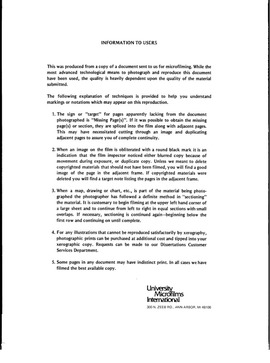| dc.contributor.author | Nichols, Mentorry Debose. | en_US |
| dc.date.accessioned | 2013-08-16T12:28:30Z | |
| dc.date.available | 2013-08-16T12:28:30Z | |
| dc.date.issued | 1982 | en_US |
| dc.identifier.uri | https://hdl.handle.net/11244/4959 | |
| dc.description.abstract | The changes for the better for the mentally retarded in the last twenty years have been slow but constant, although the rate of change did accelerate in the 1970's. The Education for All Handicapped Children Act of 1975, Public Law (P.L.) 94-142, moreover gave a great stimulus to the treatment of all children with handicaps, and also encouragement to their parents and those advocates who work with them. | en_US |
| dc.description.abstract | Although mental retardation is a problem which affects many families and in which many people, as a result, have more than a passing interest, the mentally retarded had not often been well studied for a considerable time. It was the purpose of this doctoral study to document those changes in attitudes, interests, and areas of concern in the last two decades, 1960 to 1980, which were observed in the contents of textbooks used in colleges and universities in the training of special educators to deal with the mentally handicapped and their special needs. | en_US |
| dc.description.abstract | In the last few decades, prejudice, shame, and indifference on the part of the public have given way to more enlightened attitudes and general concern, as can be observed in the development of local and national programs and agencies. Moreover, laws have been passed to aid the mentally handicapped and to protect their legal rights and to guarantee them such educational benefits as well as prepare them for useful lives in society. | en_US |
| dc.description.abstract | This study was based on a content analysis of textbooks dealing specifically with mental retardation and showed, in terms of numbers of pages, the amount of consideration given to various areas of concern and, in percentages, the increase or decrease in the coverage of specific areas within the four five-year periods into which the last twenty years were divided for this study. The twelve textbooks from 1960-1980 that were used in this study were divided into four time periods of five years each. These time periods are shown in Table 4, in which a total of all content-categories across books and time is given. The fifth column shows a total percentage for all four time periods. | en_US |
| dc.description.abstract | As recorded in this study, changes have taken place and new trends have emerged in the past two decades: first, the numbers of special classroom teachers being trained have grown tremendously; there have been major changes in curriculum and methodology; there is growth in resource rooms, teacher aides, Head Start programs (although the Head Start program has been phased out as such). Also a new emphasis became evident in residential care in the 1970's. | en_US |
| dc.format.extent | v, 83 leaves ; | en_US |
| dc.subject | Education, Special. | en_US |
| dc.title | Progress in mental retardation according to the content of textbooks published between 1960 and 1980. | en_US |
| dc.type | Thesis | en_US |
| dc.thesis.degree | Ph.D. | en_US |
| dc.thesis.degreeDiscipline | Jeannine Rainbolt College of Education | en_US |
| dc.note | Source: Dissertation Abstracts International, Volume: 43-02, Section: A, page: 0420. | en_US |
| ou.identifier | (UMI)AAI8215793 | en_US |
| ou.group | Jeannine Rainbolt College of Education | |
